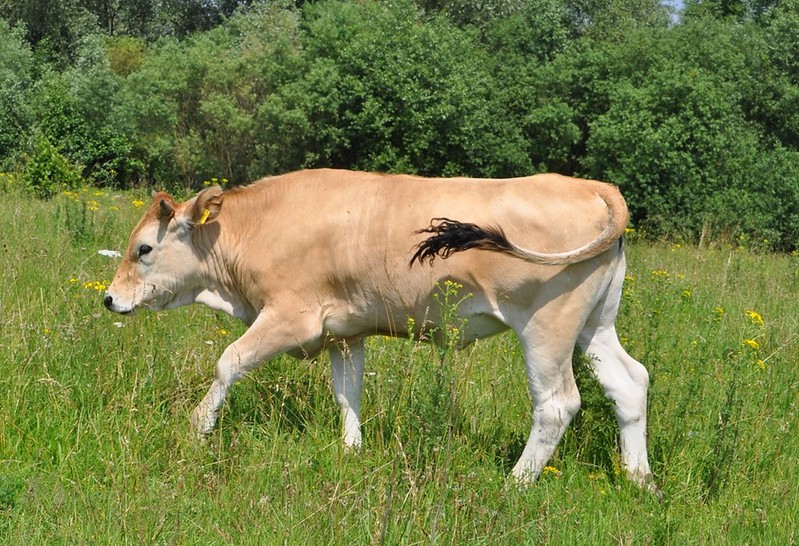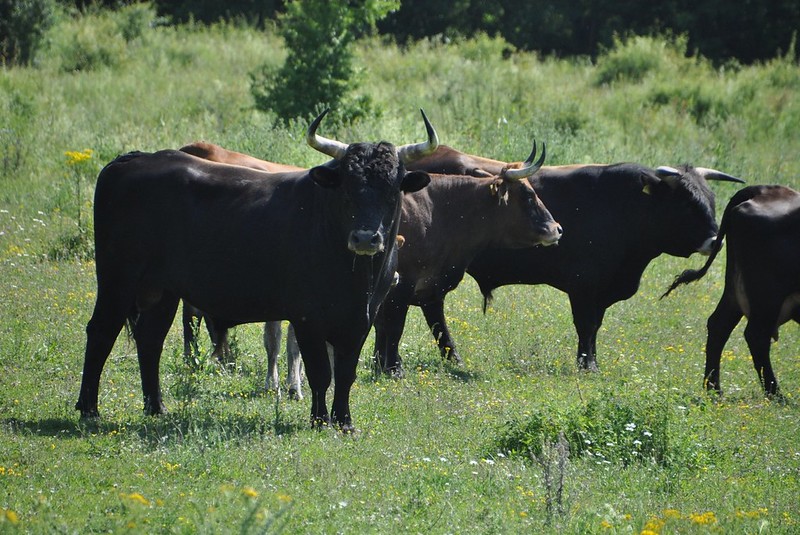Denmark was
the second country after Germany to breed a herd of Taurus cattle. They started
in 2003 with a number of individuals from the Lippeaue. Since you find a
precise description of the history of that herd and the selection criteria at
Vildmose on this thread (post #1051 and following), I am not going to go over
it in great detail here.

The early
breeding bull in this herd was a Chianina x Heck named Leonardo, now
slaughtered and half-blood brother of Luca and also one of the earliest, if not
the first, Chianina-cross at the Lippeaue. As an F1, he had a full set of
Chianina chromosomes and a full set of Heck chromosomes to pass on to his
offspring. As a consequence, many of those cattle are rather Chianina-influenced,
which is a) good for achieving long legs, a slender body and large size, b)
results in many individuals with a diluted fur colour. However, the influence
of Sayaguesa is not totally absent, some of them have nice elongate snouts, and
there are in fact individuals with an authentic aurochs colour. They also imported Lidia cows, but did not continue using them or their offspring because of their temperament.
Here are
some photos of those cattle that I took from their status reports (see the
Carnivora thread):
 |
| 1 |
 |
| 2 |
 |
| 3 |
 |
| 4 |
 |
| 5 |
 |
| 6 |
 |
| 7-1 |
 |
| 7-2 |
 |
| 8 |
 |
| 9 |
 |
| 10 |
 |
| 11 |
 |
| 12 |
 |
| 13 |
 |
| 14 |
 |
| 15 |
 |
| 16 |
 |
| 17 |
 |
| 18 |
 |
| 19 |
 |
| 20 |
 |
| 21 |
 |
| 22 |
 |
| 23 |
 |
| 24 |
 |
| 25 |
 |
| 26 |
 |
| 27 |
 |
| 28 |
 |
| 29 |
 |
| 30 |
The cows on
#1 and #2 are obviously Sayaguesa-influenced. #3 probably shows one of Leonardo’s
sons, and #4 shows Leonardo with the rest of the herd. The cows on #7-2, #11 and
#14 have a nice slender and long-legged body, although they have – the
exception of the latter one – a rather diluted colour. #29 shows a part of the
herd, along with a bull that is very likely another son of Leonardo (the same
as the one on #21?). While the bull on #13 seemingly looks like usual Heck
bull, those on #21 and #24 look cool to me because of their 1:1 trunk
length/withers height relation – and so is the cow on #23. Rather awesome in my
opinion. Surely, their diluted colour is not desirable, but colour is regulated
by only a few loci so I do not worry that much about it. I simply consider
proportions, body size and body shape more important at this stage. When you
look at the bull on #12 and remember the photos I took at the Lippeaue, you
might realize that this bull has the same colour as “Larissa” (see here), a
Chianina x 25% Chianina cow. If my knowledge on cattle coat colour genetics is
correct, both individuals should be heterozygous for the Dun dilution allele,
which results in a tan colouration (see Leonardo, or Luca linked above), homozygous for
the Agouti dilution which causes the whitish base colour.
None of the
individuals we see in the status reports have remarkable horns – neither in
regards to dimensions nor curvature.
To sum it
up, the herd at Lille Vildmose, mostly composed of individuals descending from
Heck and Chianina but also Sayaguesa influence, has the potential to give rise
to large and well-proportioned animals, and some also have elongated snouts.
But the Chianina influence produces many individuals with diluted fur colour,
and the horns are not good. They use 3 Sayaguesa bulls as new breeding bulls
now. This should help to clear of all the dilution alleles and increase the
snout length. It also must be expected that more individuals with
forwards-facing horns have been born thanks to the new bulls (although the
horns probably will not get perfect yet, Sayaguesa only rarely have
inwards-facing horns and the dimensions are still insufficient).
We should
mind that this post and those in the forum are based on status reports from
several years ago, so that we do not know the most recent breeding results and
the current state of the herd. I hope they are not going to use the Sayaguesa
bulls for too long, otherwise the herd gets “Sayaguesa-ized” and becomes more
and more like that breed, while the chance for achieving individuals exceeding
a size of 165 cm gets ever smaller. A 170 cm Taurus bull is outstanding yet, in
Denmark as much as in Germany and Hungary.
What
worries me as well are the selection criteria (see the thread). For example,
they accept saddles for bulls and wholly black cows, what means that no
selection for colour dimorphism takes place.




































